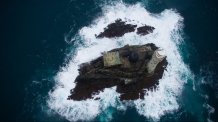Articles

The dramatic image has been selected as one of the very best in a prestigious national contest. Image courtesy of James Bassitt.
Stunning image of storm waves crashing against lighthouse wins critical acclaim
A stunning photograph offering a bird’s eye view of waves crashing against the craggy rocks housing a remote lighthouse has received critical acclaim.
The dramatic image, which shows a stormy aerial view of the Fastnet rock located off the coast of Ireland, has been selected as one of the very best in a prestigious national contest.
The photo, captured by University of Exeter engineering expert James Bassitt by using a drone, features among the top entries in the Science Photo Competition, organised by the Engineering and Physical Sciences Research Council (EPSRC).
The competition allows researchers and doctoral students to share their work in pictures, with winners from categories ranging from ‘eureka’ to ‘weird and wonderful’.
The spectacular, powerful image was taken this winter, when James was part of a collaborative research team visiting Fastnet rock as part of their project to study the impact waves have on some of the most exposed lighthouses in the UK and Ireland.
James, used an ordinary drone to capture the stormy waves thundering against the rocks, close to where he was standing on the concrete helipad. The ferocity of the wave, which sent sea spray shooting wildly into the air, caused the drone to fail soon afterwards.
The tempestuous conditions forced the team to spend an extra three nights camped out in the lighthouse. The powerful photo secured second spot in the ‘People and Skills’ category of the awards.
James, who is a Vibration Engineering Section Experimental Officer at the University of Exeter said: “I’m really pleased that the photo did so well in the competition. The ferocity of the waves and the lighting give the lighthouse quite an imposing and almost bleak view, which adds to the ‘wow’ factor overall.
“The project is all about exposed lighthouses, and this photo really captures the essence of why Fastnet was selected, it shows its isolation, but also how open to the elements it really is.”
Speaking about the competition, Professor Tom Rodden, EPSRC’s Deputy Chief Executive, said: “The quality of entries into our competition demonstrates that EPSRC-funded researchers are keen to show the world how beautiful and interesting science and engineering can be. I’d like to thank everyone who entered; judging was really difficult.
“These stunning images are a great way to engage the public with the research they fund, and inspire everyone to take an interest in science and engineering.”
James is part of a team drawn from the Universities of Exeter, Plymouth and UCL who are using a variety of field and laboratory tests, with computer modelling, to evaluate the level of vibration the lighthouses endure from the constant battering of the sea.
The lighthouses studied are Les Hanois, in the English Channel near Guernsey; Bishop Rock, Wolf Rock and Longships, in Cornwall; Fastnet, to the south of Ireland; and Dubh Artach, off the west coast of Scotland.
The project – called STORMLAMP (STructural behaviour Of Rock Mounted Lighthouses At the Mercy of imPulsive waves) - is being funded by a £1,000,000 grant from the EPSRC and will extend over the next three and a half years.
Date: 3 April 2017
